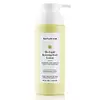What's inside
What's inside
 Key Ingredients
Key Ingredients

No key ingredients
 Benefits
Benefits

 Concerns
Concerns

 Ingredients Side-by-side
Ingredients Side-by-side

Water
Skin ConditioningCarthamus Tinctorius Seed Oil
MaskingCetyl Alcohol
EmollientGlycerin
HumectantCaprylic/Capric Triglyceride
MaskingButyrospermum Parkii Butter
Skin ConditioningDimethicone
EmollientC10-18 Triglycerides
EmollientMoringa Oleifera Seed Oil
EmollientNiacinamide
SmoothingRosa Canina Fruit Oil
EmollientPanthenol
Skin ConditioningSodium PCA
HumectantSodium Stearoyl Glutamate
CleansingSqualane
EmollientVaccinium Myrtillus Fruit Extract
Skin ConditioningSaccharum Officinarum Extract
MoisturisingRiboflavin
Cosmetic ColorantTocopherol
AntioxidantCitrus Aurantium Dulcis Fruit Extract
MaskingCitrus Limon Fruit Extract
MaskingSodium Glycolate
BufferingCamellia Sinensis Leaf Extract
AntimicrobialSpilanthes Acmella Flower Extract
Skin ConditioningSodium Formate
BufferingAcer Saccharum Extract
Skin ConditioningSodium Hyaluronate
HumectantCetearyl Olivate
Sorbitan Olivate
EmulsifyingPhenoxyethanol
PreservativeCarbomer
Emulsion StabilisingTocopheryl Acetate
AntioxidantEthylhexylglycerin
Skin ConditioningSodium Hydroxide
BufferingTetrasodium Glutamate Diacetate
Citric Acid
BufferingPotassium Sorbate
PreservativeSodium Benzoate
MaskingWater, Carthamus Tinctorius Seed Oil, Cetyl Alcohol, Glycerin, Caprylic/Capric Triglyceride, Butyrospermum Parkii Butter, Dimethicone, C10-18 Triglycerides, Moringa Oleifera Seed Oil, Niacinamide, Rosa Canina Fruit Oil, Panthenol, Sodium PCA, Sodium Stearoyl Glutamate, Squalane, Vaccinium Myrtillus Fruit Extract, Saccharum Officinarum Extract, Riboflavin, Tocopherol, Citrus Aurantium Dulcis Fruit Extract, Citrus Limon Fruit Extract, Sodium Glycolate, Camellia Sinensis Leaf Extract, Spilanthes Acmella Flower Extract, Sodium Formate, Acer Saccharum Extract, Sodium Hyaluronate, Cetearyl Olivate, Sorbitan Olivate, Phenoxyethanol, Carbomer, Tocopheryl Acetate, Ethylhexylglycerin, Sodium Hydroxide, Tetrasodium Glutamate Diacetate, Citric Acid, Potassium Sorbate, Sodium Benzoate
Water
Skin ConditioningGlycerin
HumectantDimethicone
EmollientStearic Acid
CleansingCaprylic/Capric Triglyceride
MaskingGlycol Stearate
EmollientPEG-100 Stearate
Petrolatum
EmollientGlyceryl Stearate
EmollientCaprylyl Glycol
EmollientPhenoxyethanol
PreservativeCetyl Alcohol
EmollientAcrylates/C10-30 Alkyl Acrylate Crosspolymer
Emulsion StabilisingTriethanolamine
BufferingParfum
MaskingHelianthus Annuus Seed Oil
EmollientTriolein
Skin ConditioningDisodium EDTA
Stearamide Amp
Carbomer
Emulsion StabilisingAlpha-Isomethyl Ionone
PerfumingCitronellol
PerfumingHexyl Cinnamal
PerfumingLimonene
PerfumingLinalool
PerfumingCI 77891
Cosmetic ColorantWater, Glycerin, Dimethicone, Stearic Acid, Caprylic/Capric Triglyceride, Glycol Stearate, PEG-100 Stearate, Petrolatum, Glyceryl Stearate, Caprylyl Glycol, Phenoxyethanol, Cetyl Alcohol, Acrylates/C10-30 Alkyl Acrylate Crosspolymer, Triethanolamine, Parfum, Helianthus Annuus Seed Oil, Triolein, Disodium EDTA, Stearamide Amp, Carbomer, Alpha-Isomethyl Ionone, Citronellol, Hexyl Cinnamal, Limonene, Linalool, CI 77891
 Reviews
Reviews

Ingredients Explained
These ingredients are found in both products.
Ingredients higher up in an ingredient list are typically present in a larger amount.
This ingredient is an emollient, solvent, and texture enhancer. It is considered a skin-softener by helping the skin prevent moisture loss.
It helps thicken a product's formula and makes it easier to spread by dissolving clumping compounds.
Caprylic Triglyceride is made by combining glycerin with coconut oil, forming a clear liquid.
While there is an assumption Caprylic Triglyceride can clog pores due to it being derived from coconut oil, there is no research supporting this.
Learn more about Caprylic/Capric TriglycerideCarbomer is a polymer of acrylic acid. Its main role is to create a gel consistency.
A high amount of carbomer can cause pilling or balling up of products. Don't worry, most products contain 1% or less of carbomer.
Cetyl Alcohol is a fatty alcohol. Fatty Alcohols are most often used as an emollient or to thicken a product.
Its main roles are:
Though it has "alcohol" in the name, it is not related to denatured alcohol or ethyl alcohol.
The FDA allows products labeled "alcohol-free" to have fatty alcohols.
Learn more about Cetyl AlcoholDimethicone is a type of synthetic silicone created from natural materials such as quartz.
What it does:
Dimethicone comes in different viscosities:
Depending on the viscosity, dimethicone has different properties.
Ingredients lists don't always show which type is used, so we recommend reaching out to the brand if you have questions about the viscosity.
This ingredient is unlikely to cause irritation because it does not get absorbed into skin. However, people with silicone allergies should be careful about using this ingredient.
Note: Dimethicone may contribute to pilling. This is because it is not oil or water soluble, so pilling may occur when layered with products. When mixed with heavy oils in a formula, the outcome is also quite greasy.
Learn more about DimethiconeGlycerin is already naturally found in your skin. It helps moisturize and protect your skin.
A study from 2016 found glycerin to be more effective as a humectant than AHAs and hyaluronic acid.
As a humectant, it helps the skin stay hydrated by pulling moisture to your skin. The low molecular weight of glycerin allows it to pull moisture into the deeper layers of your skin.
Hydrated skin improves your skin barrier; Your skin barrier helps protect against irritants and bacteria.
Glycerin has also been found to have antimicrobial and antiviral properties. Due to these properties, glycerin is often used in wound and burn treatments.
In cosmetics, glycerin is usually derived from plants such as soybean or palm. However, it can also be sourced from animals, such as tallow or animal fat.
This ingredient is organic, colorless, odorless, and non-toxic.
Glycerin is the name for this ingredient in American English. British English uses Glycerol/Glycerine.
Learn more about GlycerinPhenoxyethanol is a preservative that has germicide, antimicrobial, and aromatic properties. Studies show that phenoxyethanol can prevent microbial growth. By itself, it has a scent that is similar to that of a rose.
It's often used in formulations along with Caprylyl Glycol to preserve the shelf life of products.
Water. It's the most common cosmetic ingredient of all. You'll usually see it at the top of ingredient lists, meaning that it makes up the largest part of the product.
So why is it so popular? Water most often acts as a solvent - this means that it helps dissolve other ingredients into the formulation.
You'll also recognize water as that liquid we all need to stay alive. If you see this, drink a glass of water. Stay hydrated!
Learn more about Water